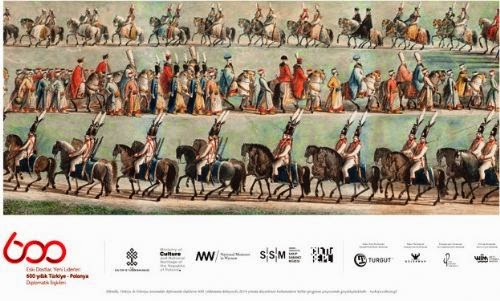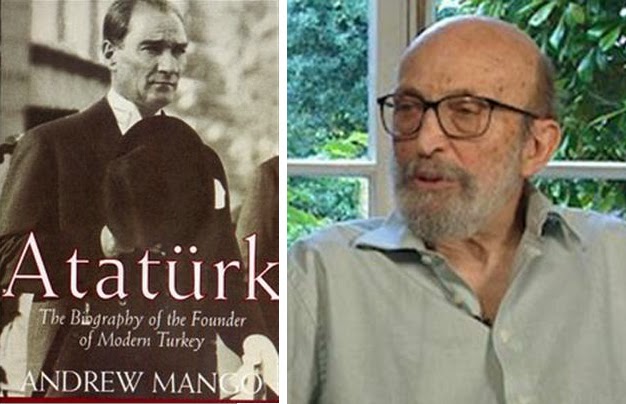 SEE Mavi Boncuk post: Ottoman Polish Armed Conflicts 1497-1699
SEE Mavi Boncuk post: Ottoman Polish Armed Conflicts 1497-1699Mavi Boncuk |
600 Years of Turkish - Polish Relations
The celebrations of the 600th anniversary of the establishment of diplomatic relations between the Ottoman Empire and the Kingdom of Poland (Lehistan) is being held during the year 2014, in Turkey and in Poland, as well as in third countries.
The 600-year-old relations, is not only an exceptional phenomenon for political
history, but also illustrates a very important period during which cultural
interactions between Turks and Poles vividly took place. It is worth mentioning that even though transport and communication were not as easy and as quick as today, cordial relations among the two brotherly nations were able to flourish. During the 16th-18th centuries when Turkey and Poland were neighbours, the interactions gained momentum.
Throughout the long period of history, Turks and Poles had also faced each other in military conflicts. However, the general characteristics of Turkish-Polish relations
have been mainly peaceful and focused on political, commercial, cultural and societal interplay among Turks and Poles. To cite some examples, the cultural interactions among the two peoples and their mutual reflections on the daily lives of Turks and Poles have been remarkable. The words of Turkish origin, such as torba, yogurt, kilim, arbuz (karpuz) can be found today in the Polish language. Turkish influence could be widely seen in the carpet designs, clothings, fashion and decorations, weaponry and even architecture in Poland. The Polish experts’ contributions in particular in the field of fine arts and industry have been very useful in Turkey during the 19th and 20th centuries. According to Polish sources, two envoys from Poland visited Bursa in 1414 during
the reign of Sultan Çelebi Mehmet, which has been acknowledged as the beginning
of the diplomatic relations between two countries. In the records it has been
mentioned that a mission from the King of Poland had arrived in İstanbul in 1565 to buy velvet from Bursa. Bursa, today is one of the cities, which is actively taking place in the 600th anniversary celebrations with its rich culture and cuisine, as well as textile industry.
Hürrem Sultan (Roksolana), well-known not only for her admirable beauty, but also due to her dominant position at the Ottoman court as the spouse of the Magnificent Sultan Süleyman, was born in the territories of Poland.
Seyyid Numan Efendi, who was sent to Poland in 1776 as an envoy, brought clothes, coffee, tobacco, guns and thoroughbred horses with him. On his return to Turkey, he took the gifts of the King of Poland to the Sultan: a china set, which is today known to be present at the Topkapı Museum, and a musical clock and precious stones. The indispensable role of art and artists, has no doubt, been very important in the construction of this mutual affection. Poland’s worldwide-known poet Adam Mickiewicz, who passed away in İstanbul in 1855, is also very important for Turkey’s cultural heritage. Poland’s national poet expressed his gratitude towards Turkey with the following words: “The only voice that rose against the dismemberment of Poland was Turkey’s. We Poles cherish the Turks for not having yielded to force in front of our enemy and for not having consented to the partition of our homeland.”
The Adam Mickiewicz Museum in İstanbul, is envisaged to host a “Joint
Commemoration Programme for Adam Mickiewicz and Nazım Hikmet” organised
by the Ministry of EU Affairs of the Republic of Turkey in November 2014.
Albert/Wojciech Bobowski [1] was a Pole who fell prisoner to the Turks during the 17th century and became Muslim and entered the service of the Ottoman Sultans as interpreter. Speaking 15-16 languages, he was a multi-talented personality in the field of music and miniature drawing as well. He was the first to translate the Holy Bible into Turkish. He wrote “Mecmua-i saz ü söz”, the musical anthology comprised of old Turkish classical music pieces and the oldest versions of the folk melodies, according to the Western note system. His manuscripts and books are not only invaluable for Turks and Poles, but are also a great treasure for the history of civilisations. Today they are known to be at the British Library, Leiden University Library, Bibliothèque Nationale de France, Österreichische Nationalbibliothek and Harvard University Houghton Library.
Many concerts, workshops and seminars are envisaged throughout the year 2014 to pay tribute to Santuri Ali Ufki Bey/Wojciech Bobowski both in Turkey and Poland. In addition to his contributions to music, linguistics and history as an outstanding figure, one should not forget his significant role as a real intellectual in the 17th century İstanbul, embracing and reflecting two religions, two cultures and two worldviews in his works, in harmony.
The Ottoman Empire was the only country who did not recognise the partition of
Poland for 123 years. A popular saying predicted that: “Poland will be free again on the day the Turks water their horses in the Vistula”. This was realised in 1918 when Poland became independent after the Ist World War during which Turkish soldiers fought side-by-side in the Galician front. Tomb of the Turkish Soldiers in the Rakowicki Cemetery in Kraków is the home of Turkish heroes who lost their lives in Polish soil.
Polish leaders of independence movement have found refuge in the Ottoman soil.
After 1850s they settled near İstanbul in the village Adampol (Polonezköy) which
was called after Prince Adam Czartoryski. The Ottoman Empire became a safe
shelter for Polish revolutionaries. Sultan Abdülmecid, who was under pressure by
Poland’s neighbours to return the refugees, declared that he would rather renounce his throne than surrender refugees who had come to seek shelter in his domains. The credible stand of the Sultan was accepted as a gesture of courage, humanity and nobility throughout Europe. General Józef Bem (Murad Paşa), Count Michał Czajkowski (Mehmet Sadık Paşa) and Konstanty Borzęcki (Mustafa Celaleddin Paşa) were among the Poles who served in the Turkish army. Today, Polonezköy is a lovely green village, a touristic destination especially during the weekends, as it has become a green refuge for those working in metropolitan İstanbul. It is a very interesting coincidence that the grandson of Mustafa Celaleddin Paşa, Nazım Hikmet Ran, would later become a world-wide Turkish poet, who acquired Polish citizenship before his death. One should also mention the world-wide famous soprano Leyla Gencer, “La Diva Turca”, [2] who was born in Polonezköy.
Sultan Abdülaziz, who had greatly encouraged artists and commissioned works
from painters, appointed Chlebowski, from Poland, as the court painter. One of the most famous painters Jan Matejko, visited İstanbul with his family in 1872, painting fishing boats on the Bosphorus and spending some time with his friend, Chlebowski. Józef Warnia-Zarzecki [3] who was invited to İstanbul in 1883, became one of the first professors at the newly opened Academy of Fine Arts of İstanbul. Coincidentally, the sketches by Sultan Abdülaziz, are at the National Museum in Kraków today. Yahya Kemal Beyatlı, famous Turkish poet, was one of the first envoys sent to Warsaw, after the proclamation of the Republic, upon the authorisation of Mustafa Kemal Atatürk, the founder of the Republic of Turkey.
The Polish-Turkish House of Friendship in Szymbark, built authentically with
materials brought from Adampol/Polonezköy in Turkey, was opened in the year
2010 by H.E. Lech Wałęsa, the former President of the Republic of Poland and 1983 Nobel Peace Prize Laureate and H.E. Reşit Uman, former Ambassador of the
Republic of Turkey in Poland.
Coming to the recent decades, one should mention Roman Kosecki, one of the
legendary football players of Galatasaray at the beginning of the 1990s. Being a
member of the Polish-Turkish Friendship Group at the Polish Parliament today, he is an important personality contributing to the further enhancement of Turkish-Polish relations. Regarding football, Roman Dąbrowski, who was the famous long-distance striker of Beşiktaş should not be forgotten as well.
Today, many Poles are coming to Turkey to enjoy sun-bathing in the lovely sandy
beaches of Turkey. Many Turkish students are studying in Polish universities and
likewise many Poles in Turkish universities.
The deep-rooted Turkish-Polish friendship cannot be summaried in a short essay
However, former Minister of Foreign Affairs of the Republic of Poland Władysław
Bartoszewski, pointed out in an interview to Die Welt in 2002, “During the World
War II, when the bombardments were heard in the city, only the Ambassadors of the Holy See and Turkey did not leave Warsaw”. This robust relationship between the two staunch allies in Europe, with its strength based on sound friendship and
cooperation, as well as the rich political and cultural heritage of our 600 year-old
friendship, will certainly contribute to the further development of our ties in the
centuries ahead.
[1] Ali Ufki | Wojciech Bobowski
More information from Mavi Boncuk Archives
[2] Leyla Gencer or Ayşe Leyla Çeyrekgil (October 10, 1928 – May 10, 2008) was a world-renowned Turkish operatic soprano. Known as "La Diva Turca" (The Turkish Diva) and "La Regina" (The Queen) in the opera world,[citation needed] Gencer was a notable bel canto soprano who spent most of her career in Italy, from the early 1950s through the mid-1980s, and had a repertoire encompassing more than seventy roles. She made very few commercial recordings; however, numerous bootleg recordings of her performances exist. In particular, Gencer was associated with the heroines of Donizetti.
Leyla Gencer was born in Polonezköy (near Istanbul) to a Turkish father and a Polish mother. Her father, Hasanzade İbrahim Bey (who took the surname Çeyrekgil under the Surname Law of 1934), was a wealthy businessman, whose family was from the city of Safranbolu. Her mother, Lexanda Angela Minakovska, was a Polish Catholic family of the Lithuanian aristocracy. (She converted to Islam and chose the name Atiye after her husband's death.)
[3] Warnia Zarzecki (1850-1924)



















